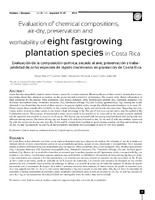Mostrar el registro sencillo del ítem
Evaluation of chemical compositions, air-dry, preservation and workability of eight fastgrowing plantation species in Costa Rica
| dc.contributor.author | Moya-Roque, Róger | |
| dc.contributor.author | Salas-Garita, Cynhtia | |
| dc.contributor.author | Berrocal-Jiménez, Alexander | |
| dc.contributor.author | Valverde-Otárola, Juan Carlos | |
| dc.date.accessioned | 2018-03-21T17:42:05Z | |
| dc.date.available | 2018-03-21T17:42:05Z | |
| dc.date.issued | 2015 | |
| dc.identifier | https://www.scielo.org.mx/pdf/mb/v21nspe/v21nspea3.pdf | es |
| dc.identifier.citation | Moya, R., Salas, C., Berrocal, A., & Valverde, J. (2015). Evaluation of chemical compositions, air-dry, preservation and workability of eight fastgrowing plantation species in Costa Rica. Revista Madera y Bosques, 21, 31-47. | es |
| dc.identifier.issn | 1405-0471 | |
| dc.identifier.uri | https://hdl.handle.net/2238/9662 | |
| dc.description | Artículo científico | es |
| dc.description.abstract | Costa Rica has successfully planted various forestry species for wood production. However, the use of their wood is limited, due to poor knowledge about their chemical properties, air-dry, preserved and workability performance. The present study details information of these properties for the species: Alnus acuminata (Aa), Acacia mangium (Am), Bombacopsis quinata (Bq), Cupressus lusitanica (Cl), Swietenia macrophylla (Sm), Terminalia amazonia (Ta), Terminalia oblonga (To) and Vochysia guatemalensis (Vg). Among the results obtained, it was found that the wood of these species is in general slightly acidic, except Bq, which presented tendency to be basic. Different species show considerable variability in the content of holocellulose, lignin and extractable micronutrients. Regarding micronutrients, and in relation to other species it was found a high percentage in Vg. The use of boron as a preservative, may be applied in the 8 plantation species. The presence of heartwood in some species made it not possible to be preserved by the vacuum-pressure method, but the sapwood was possible to preserve in all species. The drying rate increased with increasing board thickness and drying time was different among species. The fastest drying rate was found in Ta and Am, followed by Sm, To, Aa and Cl with intermediate values and Vg with the slowest air-drying rate. Am, Bq, Cl, Sm and To present from excellent to good planing, sanding , drilling and molding, but Ta, Bq, Aa and Vg, especially Aa and Vg, in the workability operations were catalogued as poor or very poor quality. | es |
| dc.language.iso | eng | es |
| dc.publisher | Revista Madera y Bosques | es |
| dc.rights | acceso abierto | es |
| dc.rights.uri | https://creativecommons.org/licenses/by-nc-sa/4.0/ | * |
| dc.source | Revista Madera y Bosques | es |
| dc.subject | Madera | es |
| dc.subject | Plantaciones forestales | es |
| dc.subject | Producción | es |
| dc.subject | Especies maderables | es |
| dc.subject | Calidad | es |
| dc.subject | Research Subject Categories::FORESTRY, AGRICULTURAL SCIENCES and LANDSCAPE PLANNING::Plant production::Forestry | es |
| dc.title | Evaluation of chemical compositions, air-dry, preservation and workability of eight fastgrowing plantation species in Costa Rica | es |
| dc.title.alternative | Evaluación de la composición química, secado al aire, preservación y trabajabilidad de ocho especies de rápido crecimiento en plantación de Costa Rica | es |
| dc.type | artículo original | es |
Ficheros en el ítem
Este ítem aparece en la(s) siguiente(s) colección(ones)
-
Artículos [37]



